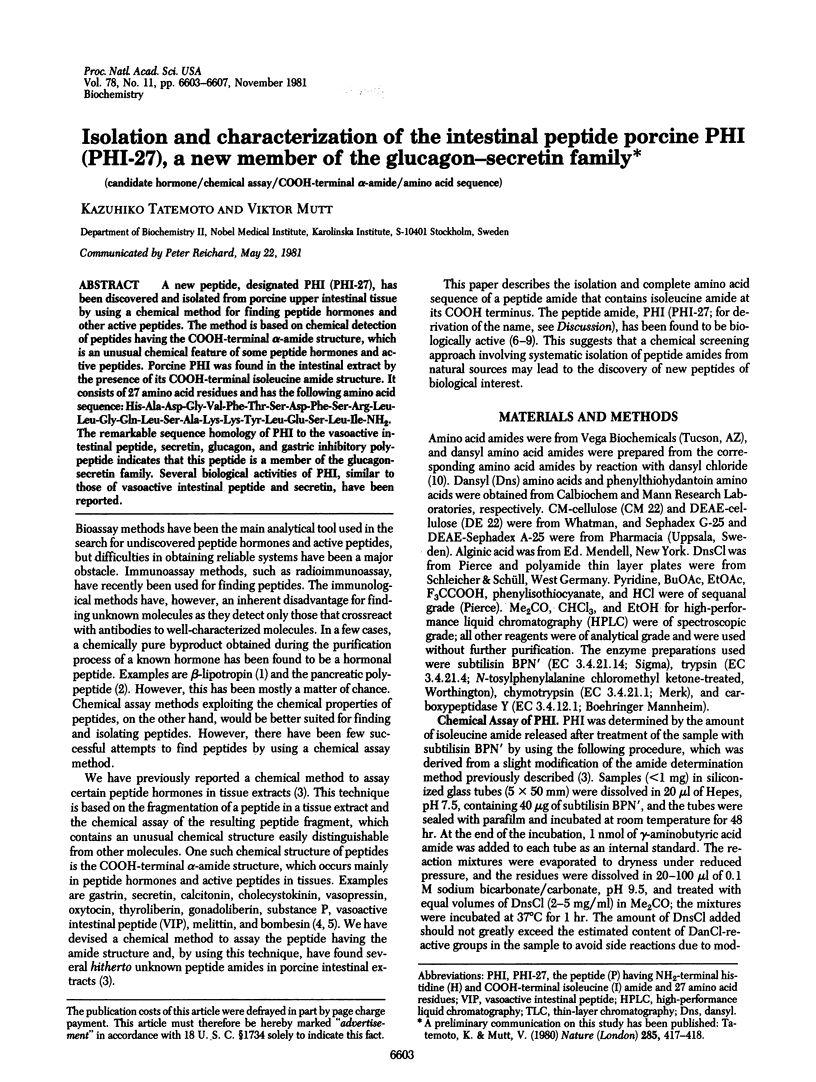Abstract
A new peptide, designated PHI (PHI-27), has been discovered and isolated from porcine upper intestinal tissue by using a chemical method for finding peptide hormones and other active peptides. The method is based on chemical detection of peptides having the cOOH-terminal alpha-amide structure, which is an unusual chemical feature of some peptide hormones and active peptides. Porcine PHI was found in the intestinal extract by the presence of its COOH-terminal isoleucine amide structure. It consists of 27 amino acid residues and has the following amino acid sequence: His-Ala-Asp-Gly-Val-Phe-Thr-Ser-Asp-Phe-Ser-Arg-Leu-Leu-Gly-Gln-Leu-Ser-Ala-Lys -Lys-Tyr-Leu-Glu-Ser-Leu-Ile-NH2. The remarkable sequence homology of PHI to the vasoactive intestinal peptide, secretin, glucagon, and gastric inhibitory polypeptide indicates that this peptide is a member of the glucagon-secretin family. Several biological activities of PHI, similar to those of vasoactive intestinal peptide and secretin, have been reported.
Full text
PDF




Images in this article
Selected References
These references are in PubMed. This may not be the complete list of references from this article.
- Bataille D., Gespach C., Laburthe M., Amiranoff B., Tatemoto K., Vauclin N., Mutt V., Rosselin G. Porcine peptide having N-terminal histidine and C-terminal isoleucine amide (PHI): vasoactive intestinal peptide (VIP) and secretin-like effects in different tissues from the rat. FEBS Lett. 1980 Jun 2;114(2):240–242. doi: 10.1016/0014-5793(80)81124-0. [DOI] [PubMed] [Google Scholar]
- Chen R. The sequence determination of a protein in a micro scale: the sequence analysis of ribosomal protein L34 of Escherichia coli. Hoppe Seylers Z Physiol Chem. 1976 Jun;357(6):873–886. doi: 10.1515/bchm2.1976.357.1.873. [DOI] [PubMed] [Google Scholar]
- Dimaline R., Dockray G. J. Actions of a new peptide from porcine intestine (PHI) on pancreatic secretion in the rat and turkey. Life Sci. 1980 Nov 24;27(21):1947–1951. doi: 10.1016/0024-3205(80)90413-0. [DOI] [PubMed] [Google Scholar]
- GRAY W. R., HARTLEY B. S. THE STRUCTURE OF A CHYMOTRYPTIC PEPTIDE FROM PSEUDOMONAS CYTOCHROME C-551. Biochem J. 1963 Nov;89:379–380. doi: 10.1042/bj0890379. [DOI] [PubMed] [Google Scholar]
- Hartley B. S. Strategy and tactics in protein chemistry. Biochem J. 1970 Oct;119(5):805–822. doi: 10.1042/bj1190805f. [DOI] [PMC free article] [PubMed] [Google Scholar]
- Hayashi R., Hata T. Action of yeast proteinase C on synthetic peptides and poly- ,L-amino acids. Biochim Biophys Acta. 1972 May 18;263(3):673–679. doi: 10.1016/0005-2795(72)90049-9. [DOI] [PubMed] [Google Scholar]
- Jörnvall H., Carlquist M., Kwauk S., Otte S. C., McIntosh C. H., Brown J. C., Mutt V. Amino acid sequence and heterogeneity of gastric inhibitory polypeptide (GIP). FEBS Lett. 1981 Jan 26;123(2):205–210. doi: 10.1016/0014-5793(81)80288-8. [DOI] [PubMed] [Google Scholar]
- Kimmel J. R., Pollock H. G., Hazelwood R. L. Isolation and characterization of chicken insulin. Endocrinology. 1968 Dec;83(6):1323–1330. doi: 10.1210/endo-83-6-1323. [DOI] [PubMed] [Google Scholar]
- Li C. H. -Lipotropin, a new pituitary hormone. Arch Biol Med Exp (Santiago) 1968;5(3):55–61. [PubMed] [Google Scholar]
- Mutt V. Further investigations of intestinal hormonal polypeptides. Clin Endocrinol (Oxf) 1976;5 (Suppl):175S–183S. doi: 10.1111/j.1365-2265.1976.tb03825.x. [DOI] [PubMed] [Google Scholar]
- Ondetti M. A., Deer A., Sheehan J. T., Pluscec J., Kocy O. Side reactions in the synthesis of peptides containing the aspartyglycyl sequence. Biochemistry. 1968 Nov;7(11):4069–4075. doi: 10.1021/bi00851a040. [DOI] [PubMed] [Google Scholar]
- Said S. I., Mutt V. Isolation from porcine-intestinal wall of a vasoactive octacosapeptide related to secretin and to glucagon. Eur J Biochem. 1972 Jul 13;28(2):199–204. doi: 10.1111/j.1432-1033.1972.tb01903.x. [DOI] [PubMed] [Google Scholar]
- Seiler N. Use of the dansyl reaction in biochemical analysis. Methods Biochem Anal. 1970;18:259–337. doi: 10.1002/9780470110362.ch5. [DOI] [PubMed] [Google Scholar]
- Szecówka J., Tatemoto K., Mutt V., Efendić S. Interaction of a newly isolated intestinal polypeptide (PHI) with glucose and arginine to effect the secretion of insulin and glucagon. Life Sci. 1980 Feb 11;26(6):435–438. doi: 10.1016/0024-3205(80)90162-9. [DOI] [PubMed] [Google Scholar]
- Tatemoto K., Mutt V. Chemical determination of polypeptide hormones. Proc Natl Acad Sci U S A. 1978 Sep;75(9):4115–4119. doi: 10.1073/pnas.75.9.4115. [DOI] [PMC free article] [PubMed] [Google Scholar]




